When Downloading Software to a Vm, Which Network Attached Is Best
What is network-attached storage (NAS)?
Network-attached storage (NAS) is dedicated file storage that enables multiple users and heterogeneous client devices to retrieve data from centralized deejay capacity. Users on a local surface area network (LAN) access the shared storage via a standard Ethernet connection.
NAS devices typically do not accept a keyboard or display and are configured and managed with a browser-based utility. Each NAS resides on the LAN as an independent network node, defined by its own unique Internet Protocol (IP) address.
NAS stands out for its ease of access, high capacity and depression cost. The devices consolidate storage in one place and support a deject tier and tasks, such every bit archiving and fill-in.
NAS and storage expanse networks (SANs) are the two main types of networked storage. NAS handles unstructured data, such as audio, video, websites, text files and Microsoft Role documents. SANs are designed primarily for cake storage inside databases, also known as structured data.
What is network-fastened storage used for?
The purpose of NAS is to enable users to collaborate and share data more effectively. It is useful to distributed teams that need remote access or work in different time zones. NAS connects to a wireless router, making information technology easy for distributed workers to access files from any desktop or mobile device with a network connectedness. Organizations commonly deploy a NAS surroundings equally the foundation for a personal or private deject.
Some NAS products are designed for use in large enterprises. Others are for home offices or small businesses. Devices usually contain at to the lowest degree two drive bays, although unmarried-bay systems are available for noncritical information. Enterprise NAS gear is designed with more than high-finish data features to aid storage management and unremarkably comes with at least iv drive trophy.
Prior to NAS, enterprises had to configure and manage hundreds or even thousands of file servers. To expand storage chapters, NAS appliances are outfitted with more or larger disks, known as scale-up NAS. Appliances are also clustered together for calibration-out storage.
In add-on, most NAS vendors partner with cloud storage providers to give customers the flexibility of redundant fill-in.
While collaboration is a virtue of NAS, information technology can as well exist problematic. Network-attached storage relies on hard disk drive drives (HDDs) to serve information. Input/output (I/O) contention can occur when besides many users overwhelm the system with requests at the same time. Newer systems use faster flash storage, either as a tier alongside HDDs or in all-wink configurations.
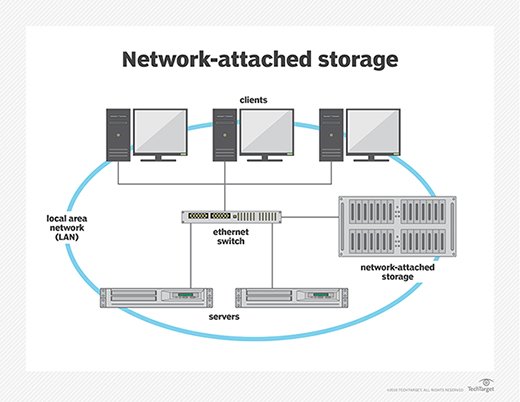
NAS use cases and examples
The applications to be used determine the type of HDD selected for a NAS device. Sharing Microsoft Excel spreadsheets or Give-and-take documents with co-workers is a routine chore, equally is performing periodic information backup. Conversely, using NAS to handle large volumes of streaming media files requires larger chapters disks, more than memory and more powerful network processing.
At domicile, people utilize a NAS organization to shop and serve multimedia files and to automate backups. Home users rely on NAS to do the following:
- manage smart Television set storage;
- manage security systems and security updates;
- manage consumer-based internet of things components;
- create a media streaming service;
- manage torrent files;
- host a personal cloud server; and
- create, test and develop a personal website.
In the enterprise, NAS is used:
- as a backup target, using a NAS array, for archiving and disaster recovery;
- for testing and developing web-based and server-side web applications;
- for hosting messaging applications;
- for hosting server-based, open up source applications such as customer relationship management, man resource management, and enterprise resource planning applications; and
- for serving electronic mail, multimedia files, databases and print jobs.
An example of how enterprises employ the technology is when a company imports many images every day. The company cannot stream this information to the deject because of latency. Instead, it uses an enterprise-class NAS to store the images and cloud caching to maintain connections to the images stored on bounds.
College-cease NAS products accept enough disks to back up redundant array of independent disks, or RAID, which is a storage configuration that turns multiple hard disks into one logical unit to boost performance, high availability and redundancy.
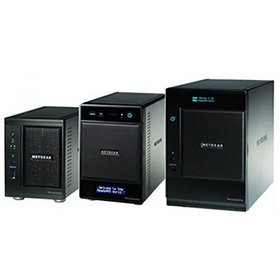
NAS product categories
NAS devices are grouped in iii categories based on the number of drives, drive support, bulldoze capacity and scalability.
Loftier-end or enterprise
The loftier terminate of the market is driven by organizations that demand to store vast quantities of file data, including virtual automobile (VM) images. Enterprise devices provide rapid access and clustering capabilities. The clustering concept addresses drawbacks associated with traditional NAS.
For example, one device allocated to an organisation's primary storage space creates a potential unmarried point of failure. Spreading mission-critical applications and file information across multiple boxes and adhering to scheduled backups decrease the take chances.
Clustered NAS systems also reduce NAS sprawl. A distributed file organization runs meantime on multiple NAS devices. This approach provides admission to all files in the cluster, regardless of the physical node on which information technology resides.
Midmarket
The midmarket accommodates businesses that require several hundred terabytes (TB) of information. These devices cannot exist amassed, nonetheless, which can atomic number 82 to file system siloes if multiple NAS devices are required.
Low-end or desktop
The depression end is aimed at home users and small businesses that require local shared storage. This market is shifting toward a cloud services model, with products such as Buurst'south SoftNAS Cloud and software-divers storage (SDS) from legacy storage vendors.
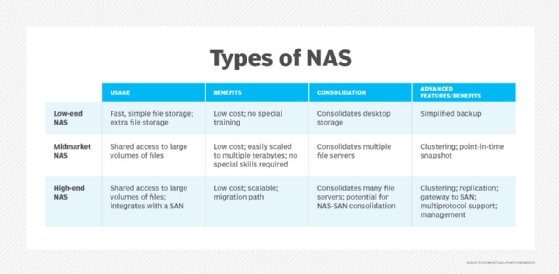
NAS deployments for business organization
The chart below describes five unlike ways network-attached storage can be deployed and lists the pros and cons for each approach. Each deployment can easily be managed by a unmarried network managing director.
The different deployment approaches include:
- NAS gateways. These are all-time for large, enterprise-class users who take a SAN.
- Integrated NAS. This approach works well for users of all sizes without a SAN.
- Amassed file systems. Large compute cluster users who need high-performance admission to file data notice these amassed file systems
- Parallel file systems. These also work well for big compute cluster users requiring high-performance file information admission or any organization needing parallel access to file data.
- NAS aggregators. These are ideal for multibox and multivendor environments.
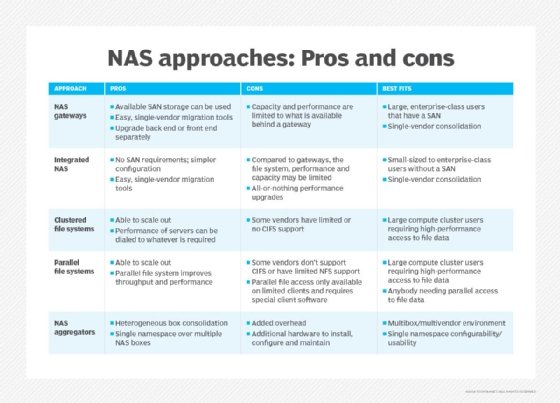
What'southward the future of network-attached storage?
The baseline functionality of NAS devices has broadened to support virtualization. High-end NAS products may likewise support data deduplication, wink storage, multiprotocol access and data replication.
Some NAS devices run a standard operating system, such as Microsoft Windows, while others run a vendor'southward proprietary OS. IP is the most common data ship protocol, but some midmarket NAS products may support boosted protocols, such as:
- Network File System
- Internetwork Packet Substitution
- NetBIOS Extended User Interface
- Server Message Block (SMB)
- Common Internet File System (CIFS)
Additionally, high-end NAS devices may support Gigabit Ethernet for even faster data transfer across the network.
Some larger enterprises are switching to object storage for capacity reasons. Yet, NAS devices are expected to go on to be useful for pocket-sized and medium-sized businesses.
Scale-upward and scale-out NAS vs. object storage
Calibration-up and scale-out are two versions of NAS. Object storage is an alternative to NAS for handling unstructured data.
Calibration-up NAS
In a network-fastened storage deployment, the NAS head is the hardware that performs the command functions. Information technology provides access to back-end storage through an cyberspace connection. This configuration is known as scale-up architecture. A 2-controller organisation expands chapters with the add-on of drive shelves, depending on the scalability of the controllers.
Calibration-out NAS
With scale-out systems, the storage administrator installs larger heads and more than hard disks to boost storage capacity. Scaling out provides the flexibility to arrange to an organization's business needs. Enterprise scale-out systems tin store billions of files without the performance tradeoff of doing metadata searches.
Object storage
Some industry experts speculate that object storage volition overtake scale-out NAS. Nonetheless, it's possible the two technologies will keep to office adjacent. Both storage methodologies deal with scale, merely in different means.
NAS files are centrally managed via the Portable Operating System Interface (POSIX). It provides data security and ensures multiple applications tin share a scale-out device without fear that i application will overwrite a file being accessed by other users.
Object storage is a new method for easily scalable storage in web-scale environments. It is useful for unstructured data that is not easily compressible, particularly large video files.
Object storage does not apply POSIX or any file system. Instead, all the objects are presented in a apartment address space. Bits of metadata are added to describe each object, enabling quick identification within a flat address namespace.
NAS vs. DAS
Direct-fastened storage (DAS) refers to a dedicated server or storage device that is not continued to a network. A computer'south internal HDD is the simplest example of DAS. To access DAS files, the user must have admission to the physical storage.
DAS has meliorate performance than NAS, especially for compute-intensive software programs. In its barest class, DAS may be nothing more the drives that get in a server.
With DAS, the storage on each device must be separately managed, adding a layer of complication. Unlike NAS, DAS does not lend itself well to shared storage by multiple users.

NAS vs. SAN
What are the differences between SAN and NAS? A SAN organizes storage resources on an independent, loftier-performance network. Network-attached storage handles I/O requests for individual files, whereas a SAN manages I/O requests for contiguous blocks of data.
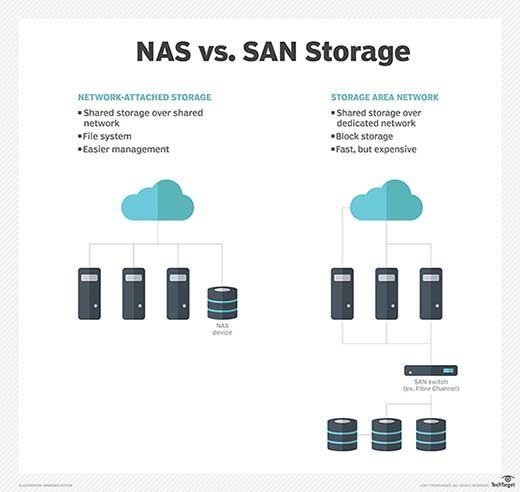
NAS traffic moves across Transmission Control Protocol/Internet Protocol, such every bit Ethernet. SAN, on the other manus, routes network traffic over the Fibre Channel (FC) protocol designed specifically for storage networks. SANs can also use the Ethernet-based Internet Small Computer System Interface (iSCSI) protocol instead of FC.
While NAS can exist a single device, a SAN provides total cake-level access to a server's deejay volumes. Put another manner, a customer OS will view NAS every bit a file system, while a SAN appears to the deejay every bit the client OS.
SAN/NAS convergence
Until recently, technological barriers accept kept the file and cake storage worlds separate. Each has had its own management domain and its ain strengths and weaknesses. The prevailing view of storage managers was that block storage is outset course and file storage is economy class. Giving rise to this notion was a prevalence of business-critical databases housed on SANs.
With the emergence of unified storage, vendors sought to meliorate large-scale file storage with SAN/NAS convergence. This consolidates block- and file-based data on 1 storage array. Convergence supports SAN block I/O and NAS file I/O in the same fix of switches.
The concept of hyper-convergence first appeared in 2014, pioneered by market leaders Nutanix and SimpliVity Corp., now office of Hewlett Packard Enterprise (HPE). Hyper-converged infrastructure (HCI) bundles the computing, network, SDS and virtualization resources on a single appliance.
HCI systems puddle tiers of different storage media and present it to a hypervisor as a NAS mountain betoken. They do this even though the underlying shared resource is block-based storage. Nevertheless, a drawback of HCI is that only the near bones file services are provided. That means a information centre may still need to implement a separate network with attached file storage.
Converged infrastructure (CI) packages servers, networking, storage and virtualization resource on hardware that the vendor has prevalidated. Unlike HCI, which consolidates devices in one chassis, CI is split up devices. This gives customers greater flexibility in edifice their storage architecture. Organizations looking to simplify storage management may opt for CI or HCI systems to supercede a NAS or SAN environment.
NAS and file storage vendors
Despite the growth in flash storage, NAS systems nonetheless primarily rely on spinning media. The list of vendors is extensive, with most offer more than ane configuration to assistance customers residual capacity and functioning.
NAS systems come fully populated with disks or equally a diskless chassis where customers add HDDs from their preferred vendor. Drive-makers Seagate Applied science, Western Digital and others piece of work with NAS vendors to develop and authorize media.
Vendors of NAS appliances or scalable file storage include the post-obit:
- Accusys Storage Ltd. supplies scalable shared flash with Peripheral Component Interconnect Express-based ExaSAN. Accusys Gamma and T-Share devices are Thunderbolt ii-designed devices with born RAID.
- Asustor is a subsidiary of Taiwanese figurer electronics behemothic Asus. Information technology offers NAS models for personal and business use.
- Buffalo Americas Inc. offers TeraStation desktop and rackmount NAS appliances. Buffalo's LinkStation NAS devices are targeted at small business and individuals.
- Buurst SoftNAS Cloud NAS software-only production enables customers to calibration information migration to Amazon Spider web Services, Microsoft Azure and VMware vSphere.
- ClearSky Information added a calibration-up NAS option equally a managed service to complement its block storage and hybrid data protection.
- DataDirect Networks specializes in storage systems for high-performance computing, including the ExaScaler arrays engineered for high parallelization.
- DataOn Storage certified its scale-out file server to enable tunable, shared amassed storage to Windows Server 2019.
- Dell EMC Isilon is a calibration-out NAS offered in a disk and an all-wink model.
- Drobo 5N NAS is a low-end complement to the Drobo B810i and B1200i iSCSI midrange arrays.
- Excelero Inc. jumped in the market in 2017 with NVMesh Server SAN software, which sits between block drives and logical file systems. It writes data straight to non-volatile memory limited devices using its patented Remote Straight Drive Access.
- Fujitsu Celvin NAS servers are suited for backup, cloud, file sharing and SAN integration cases.
- Hitachi Vantara offers Hitachi NAS Platform, which combines Hitachi's Virtual Storage Platform arrays and Storage Virtualization Operating System and is geared to large VMware environments.
- HPE branched into NAS with StoreEasy models in varying capacities and toll points.
- Huawei OceanStor 9000 features a symmetrically distributed architecture that scales from three to 288 nodes.
- IBM Spectrum NAS combines IBM Spectrum SDS with storage hardware. Spectrum NAS runs on x86 servers. IBM Spectrum Scale handles file storage for high-performance calculating. Spectrum Scale is SDS based on IBM's General Parallel File Organization.
- Infinidat built the petabyte-scale InfiniBox unified NAS and SAN assortment predominantly with deejay. It used a B-tree architecture that caches data and metadata on SSDs, enabling reads directly on the nodes.
- IXSystems Inc. designs consumer-oriented FreeNAS and TrueNAS for enterprises. Customers can purchase bundled IXSystems TrueOS software and TrueNAS hardware or download and install FreeOS on their preferred choice of servers.
- Microsoft Avere Systems FXT Edge Filer, with a file organisation designed for object storage, offers cloud-integrated hybrid storage that works with an organization's NAS and Azure Hulk Storage.
- NetApp Inc. helped pioneer the utilize of an extensible file organization with its Fabric-Fastened Storage and All Wink FAS.
- Netgear ReadyNAS is available in desktop and rackmount models as storage for hybrid and private clouds.
- Nexenta NexentaStor is SDS that also supports FC and NAS. The software runs on blank metal, VMware hosts or inside VMs on hyper-converged hardware.
- Nexsan Unity durability-focused arrays handle SAN and NAS protocols, enabling hybrid media to support mixed workloads, especially in rugged physical locations.
- Panasas ActiveStor parallel hybrid calibration-out system runs the PanFS file arrangement.
- Pure Storage positions its all-flash FlashBlade as a highly scalable platform for big data analytics.
- QNAP Systems Inc. has an extensive NAS portfolio that spans small and midsize businesses, as well as midrange and high-stop enterprises. It likewise has products for home users.
- Quantum Corp. launched Xcellis scale-out NAS to compete with Dell EMC Isilon and NetApp FAS. Xcellis uses the Quantum StorNext scalable file system.
- Qumulo Inc. Cadre file storage was developed by several of the creators of the Dell EMC Isilon engineering. The Core Bone runs on Qumulo C-series and P-series branded arrays, as well as commodity servers.
- Rackspace enterprise services include defended NAS based on the NetApp OnTap OS for managed block- and file-level storage.
- RackTop Systems integrates BrickStor unified storage with Seagate disk and StorOne enclosures and sells it as the Secure Data Protection Platform.
- Seagate BlackArmor NAS 220 enterprise arrays scale from 1 TB to 6 TB, with smaller BlackArmor models topping out at two TB. Seagate Personal Cloud NAS targets the consumer market with capacity up to five TB.
- Spectra Logic introduced BlackPearl NAS ranging from 48 TB to 420 TB of optional hybrid flash in a 4U rack.
- StorageCraft Applied science Corp. doesn't technically have NAS but positions the OneXafe platform as a calibration-out alternative.
- Synology Inc. offers NAS devices for concern and personal uses, including DiskStation NAS, FS/XS Series, J Series, Plus Series and Value Serial.
- Thecus Technology Corp. markets a range of NAS appliances.
- Verbatim Corp. PowerBay NAS supports four hot-swappable HDD cartridges that can be configured for diverse RAID levels. Verbatim is a subsidiary of Mitsubishi Chemic Corp.
- WekaIO VM-deployed NAS software gets installed on flash-enabled x86 servers, using its parallel file system to scale to trillions of files.
- Western Digital Corp. My Cloud NAS comes in various models with branded HelioSeal helium HDDs. Portable, rugged NAS also is available through Western Digital's G-Technology subsidiary.
- Zadara Storage deject NAS provides scalable file storage equally a service with the software-defined Zadara VPSA Storage Assortment.
Cloud-based file storage
In improver to NAS devices, some data centers broaden or replace physical NAS with cloud-based file storage. Amazon Elastic File System is the scalable storage in Amazon Elastic Compute Deject. Similarly, Microsoft Azure File Service furnishes managed file shares based on SMB and CIFS that local and cloud-based deployments can use.
Not every bit common now, NAS gateways formerly enabled files to access externally attached storage, either connecting to a high-functioning area network over FC or just a bunch of disks in fastened servers. NAS gateways are even so in use, just less oft; customers are more probable to use a deject storage gateway, object storage or scale-out NAS.
A cloud gateway sits at the border of a company's data center network, shuttling applications between local storage and the public cloud. Nasuni Corp. created the cloud-native UniFS file system software, bundled on Dell PowerEdge servers or bachelor every bit a virtual storage appliance.
Nasuni rival Panzura provides a similar service with its Panzura CloudFS file system and Liberty Filer enshroud appliances.
Acquire more about five key benefits of cloud storage : scalability, flexibility, multi-tenancy, simpler information migration and lower cost disaster recovery.
DOWNLOAD HERE
Posted by: schafergothis.blogspot.com
